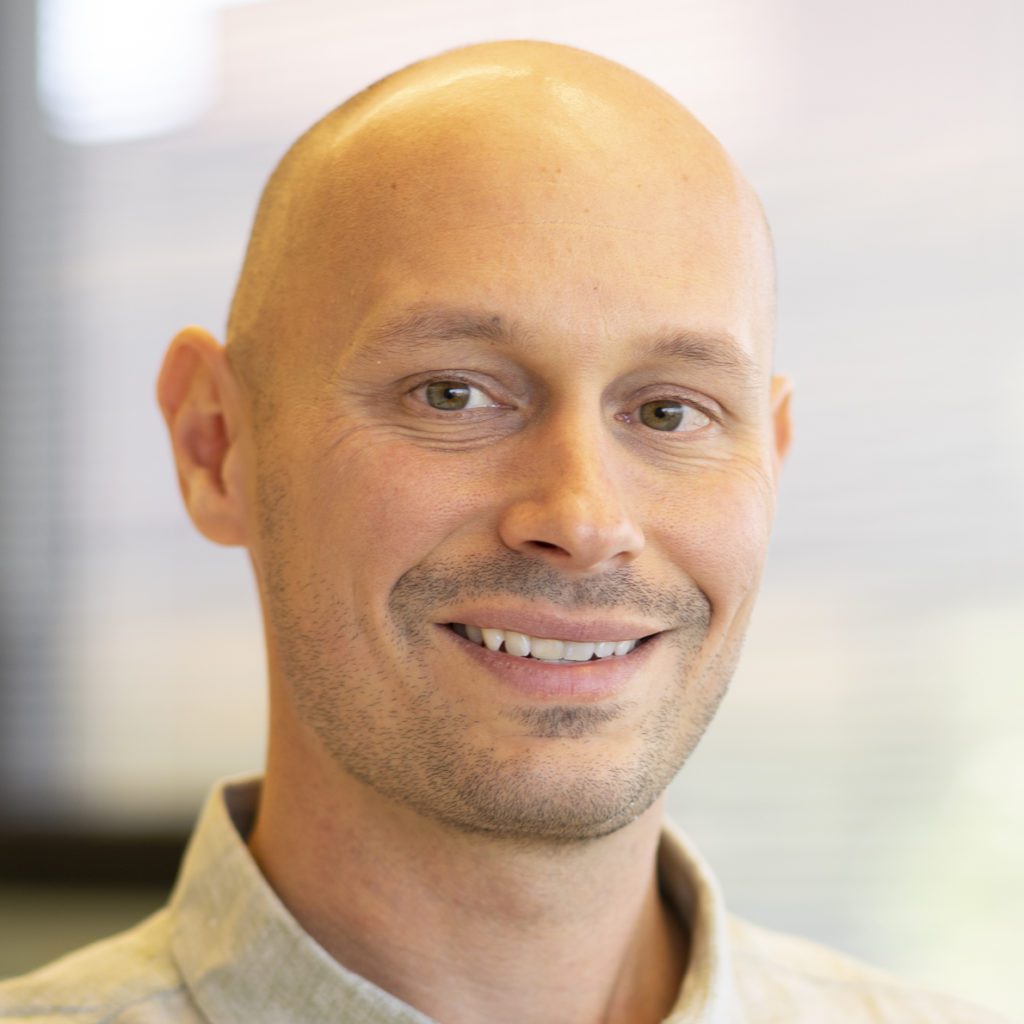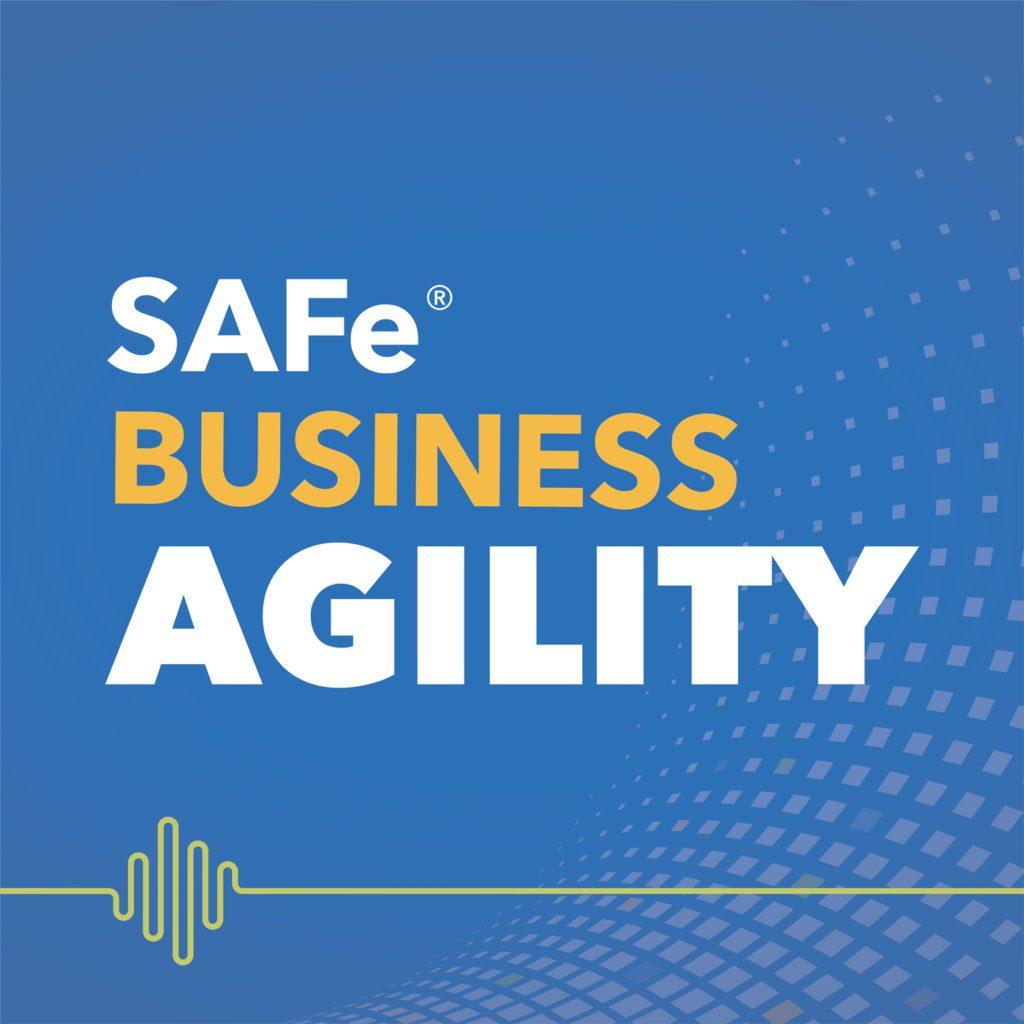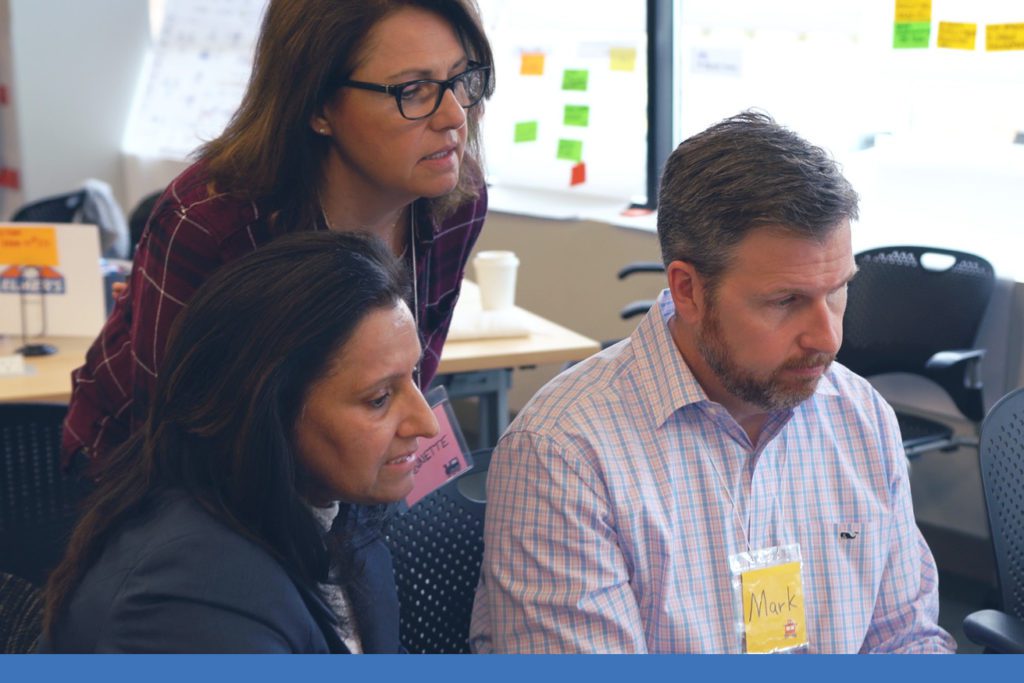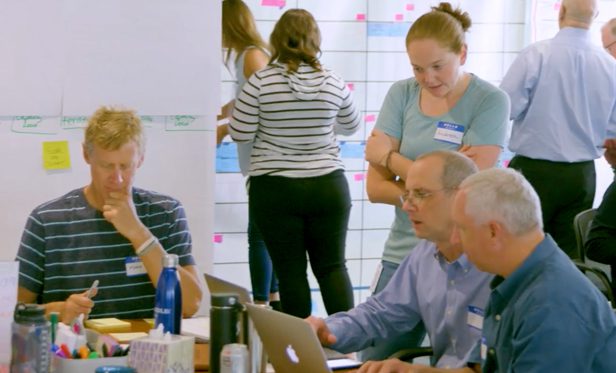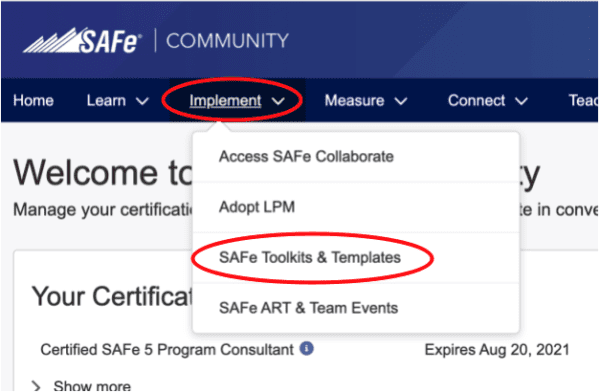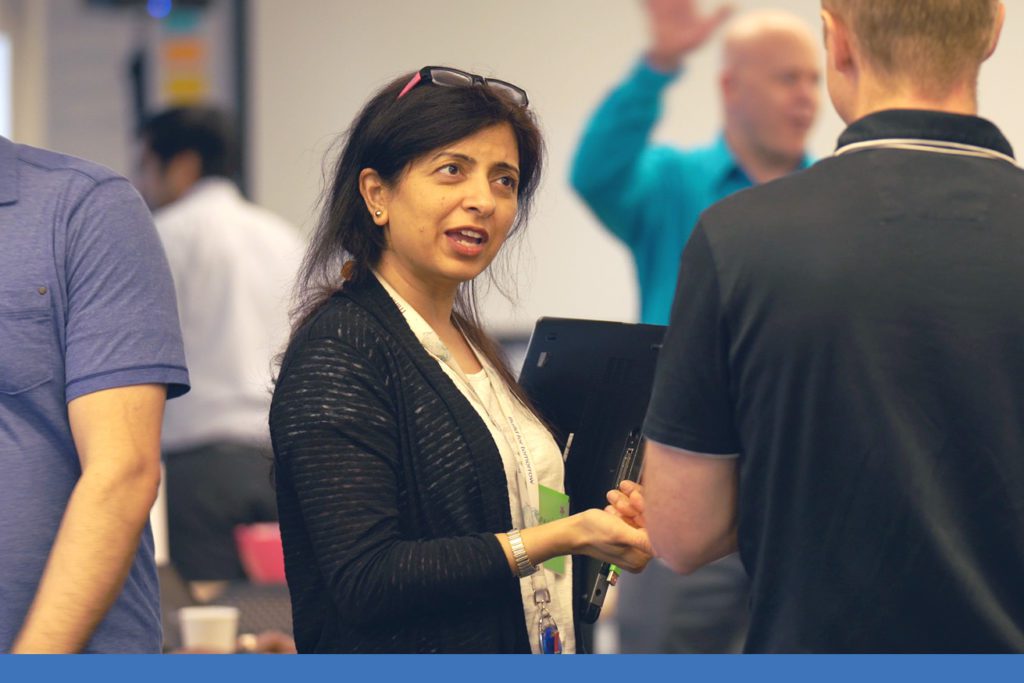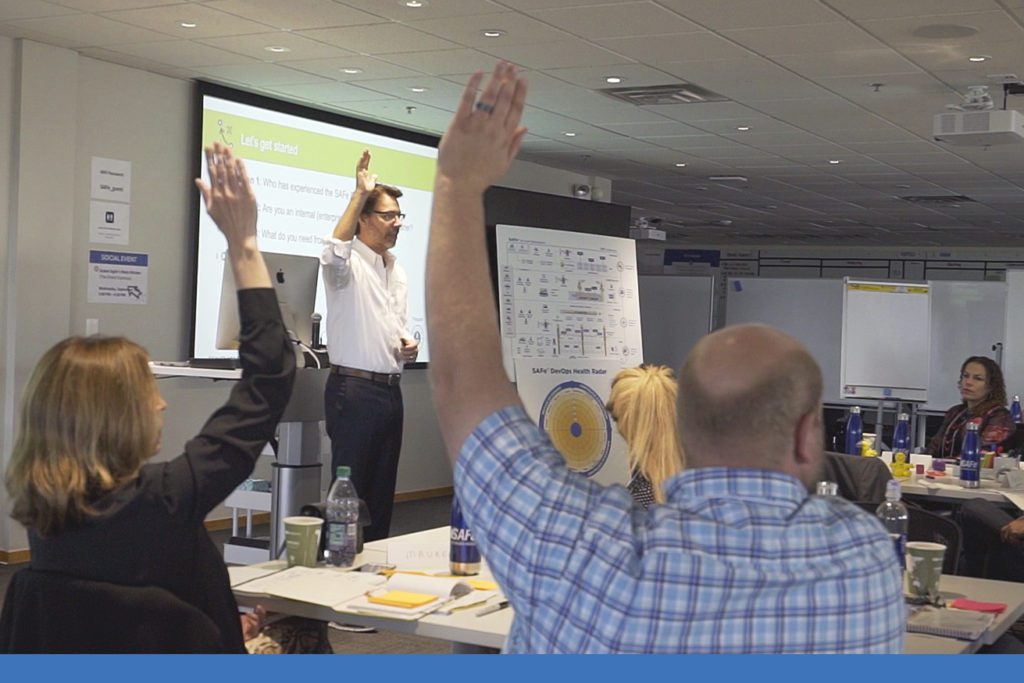
Three technology trends—artificial intelligence (AI), big data, and cloud—are converging to provide new ways of understanding, managing, and transforming products and services. What does that mean for enterprises now and in the future? In this episode, Dean Leffingwell, Scaled Agile co-founder and SAFe chief methodologist shares highlights from his 2021 Global SAFe Summit talk. He discusses the concept of the business agility value stream in applying SAFe to accelerate time-to-market and effectively compete in the second digital age.
Click the “Subscribe” button to subscribe to the SAFe Business Agility podcast on Apple Podcasts
Share:
Three technology trends—artificial intelligence (AI), big data, and cloud—are converging to provide new ways of understanding, managing, and transforming products and services. What does that mean for enterprises now and in the future? In this episode, Dean Leffingwell, Scaled Agile co-founder and SAFe chief methodologist shares highlights from his 2021 Global SAFe Summit talk. He discusses the concept of the business agility value stream in applying SAFe to accelerate time-to-market and effectively compete in the second digital age.
Topics covered in this episode include:
- Following investment capital for a glimpse into the future of technology
- How and why Porsche is using AI
- The importance of metrics
- Three key takeaways to get started
Go here to read the business agility article on the SAFe website.
Hosted by: Melissa Reeve

Melissa Reeve is the Vice President of Marketing at Scaled Agile, Inc. In this role, Melissa guides the marketing team, helping people better understand Scaled Agile, the Scaled Agile Framework (SAFe), and its mission. Connect with Melissa on LinkedIn.
Guest: Dean Leffingwell

Recognized as one of the world’s foremost authorities on Lean-Agile best practices, Dean is an entrepreneur and software development methodologist best known for creating SAFe®, the world’s most widely used framework for business agility. Connect with Dean on LinkedIn.
Navigate the Future with a Business Agility Value Stream Podcast Episode Transcript
Speaker 1
Looking for the latest news, experiences, and answers to questions about SAFe? You’ve come to the right place. This podcast is for you, the SAFe® community of practitioners, trainers, users, and everyone who engages SAFe on a daily basis.
Melissa Reeve
Welcome to the SAFe Business Agility podcast recorded from our homes around the world. I’m Melissa Reeve, your host for today’s episode. Joining me today is Dean Leffingwell, Scaled Agile co-founder, chief methodologist, and keynote speaker at the 2021 Global SAFe Summit. In this episode, Dean will share highlights from his keynote at the 2021 Global SAFe Summit, talking about business agility value streams. Thanks for joining me today, Dean. It’s so great to have you back on the show.
Dean Leffingwell
Hey, Melissa. Thanks for having me. And it’s so odd to be doing these without an in-person Summit.
Melissa Reeve
I know. We’re doing the best we can and we look forward to the conversation. Dean, in your talk at the 2021 Global SAFe Summit, you shared that by looking at financial capital, we can start to see what the future looks like. Can you elaborate on that?
Dean Leffingwell
This is triggered by my last keynote. When we introduced business agility back at version 5.0, and we were drafting a little bit of the work on the work of Mik Kersten and Carlota Perez. We were channeling some of Carlotta Perez’s work as she discussed the nature of technological revolutions and the way it changes everything about society. There was one slide that over a year and a half ago triggered my memory and just stuck with me. And that is how it is that if you want to understand where the production capital’s going to be amassed, you need to find where the investment capital is going now. In our case, the question becomes where’s the technology investment capital going, because that should help us predict where our businesses are going, where our technology needs to go, and give us a hint at the types of things we need to be doing in the future to better compete in this digital age.
Melissa Reeve
And so, what kinds of things did the data show?
Dean Leffingwell
I found three major megatrends; three, general-purpose technologies appeared again and again. One is the basic investment in the cloud—that goes without saying. I think enterprises are now spending literally hundreds of billions of dollars a year, maybe $200 or $300 billion on their transformation of the cloud. Another is big data, the presence of the cloud, the presence of more and more customers, the presence of IoT, the growth on autonomous vehicles is creating massive amounts of data and that data has to be stored someplace and then it has to be used.
Dean Leffingwell
And the third one, and I think the one that I found most compelling, is the current investment in artificial intelligence (AI). Now AI is not new. It precedes me as a software developer, but all of a sudden we’re starting to see incredible amounts of investment, not in the part of the fangs—the Facebooks, the Amazons, and the Apples, et cetera—as well as just those of us in more traditional enterprise businesses, making big investments in AI. And that says to me that these three, general-purpose technologies, AI, big data, and cloud, are coming together to create what I’m starting to think of as the next digital age, or at least the second half of the digital age we’re already in.
Melissa Reeve
So, I’ve got a couple of follow-on questions for you, Dean. The first is around Porsche and they also presented at the Global SAFe Summit. And they had a compelling story that included a little bit about AI. Can you share that story with us?
Dean Leffingwell
Yes, and there’s a bit more of a background story, which is that what we saw in the Summit was some excerpts from the Porsche interview. And as we went through the interview in detail, and we specifically drove down in the area of artificial intelligence, they talked about three areas where AI is dominant. They talked about using AI in development. So they use it to understand the performance of a vehicle on the test stand or even on the test track. They talked about embedding AI in the vehicle—how a car with literally hundreds of digital devices in it is creating data at such a rate that no programmer can possibly think through the logic of, if this happens, then we should do that.
Dean Leffingwell
And how they’re using AI to basically address the actual driving of an autonomous vehicle, as well as the safety aspects. And thirdly, they talked about how they’re using AI to better understand their customers, how they use the vehicles and various patterns of usage that wouldn’t be obvious if they didn’t have this mass data. And that informs them about potential new features that they need to build into the vehicle. So it’s a pretty comprehensive approach of in-development, in the product, and in the market of three different use cases for AI, all of which can have a significant impact in the future.
Melissa Reeve
Yeah. I mean, that’s pretty incredible to think about AI driving new product features. In fact, when I was in a conversation with a healthcare company recently, I asked them about their business use cases for AI. And they’re like, well, AI tells us what’s next. And it, it kind of blew my mind.
Dean Leffingwell
Really. AI helping figure out what the next machine learning algorithms are. That’s, that’s scary.
Melissa Reeve
I know, it’s kind of crazy. So, those kinds of implications bring us to the crux of your talk, which was the business agility value stream. Can you talk to us a little bit about that?
Dean Leffingwell
Sure. So we recognize that the SAFe big picture is a pretty complex presentation and it doesn’t tell its own story. So I wanted to think about simplifying the messaging and the application of SAFe in a way that we could really understand how we can leverage SAFe to absolutely shorten time-to-market. As we thought about that, we started thinking about, what’s the time between when you detect a business opportunity and when you address it. And that leads you to what development process we used to do that. And as opposed to traditional development, may the waterfall rest in peace, the business agility value stream lays out a general case, which is that there are a series of steps that you can go through from understanding the opportunity to building the MVP, to focusing on continuous delivery to deliver the MVP, to pivoting and deciding whether or not that’s the right thing to do, and continuing on all the way to continuous improvement.
Dean Leffingwell
So that business agility value stream is really a synthesis and a derivation that says, this is the way we should think about applying SAFe. And it brings to bear all the competencies in SAFe to help address the problem of shortening the time-to-market from the time the opportunity is identified to the time that’s delivered.
Melissa Reeve
And I think during the talk to you started to talk about the different stages in the business agility value stream. Are there one or two stages that you could highlight for our listeners?
Dean Leffingwell
Oh sure. I mean one that’s fun and I think mostly without conflict controversy is the MVP. So, there was a time in which we had maybe the arrogance or the confidence to think that we could identify a new business opportunity and go ahead and make the investment and exploit it, but we invested too much too soon and we invested it without the feedback necessary. So the MVP is a minimum viable product. It’s not a storyboard. It’s not a set of features that you throw away when you’re done with it. It’s a set of capabilities that absolutely prove that what you’re delivering to the market makes sense. And if necessary, proves the business case, and indeed allows you to check the business model where necessary to make sure that your investment is going to be proven. And then on into other elements of the value stream.
Melissa Reeve
When I was looking at the slides, you had a really compelling visual. And it was a skateboard that turned into a scooter that turned into a bicycle that, I think there was something else, but eventually it turned into a car as the MVP in each one of those modes of transportation are viable, right? It’s a viable way to get around. So it’s not about just developing it incrementally in terms of not being viable it’s got to actually do something.
Dean Leffingwell
No, I mean, the words are what it says. That’s a minimum viable product. It’s not a throwaway prototype or a storyboard or a hackathon that I put together to illustrate something. It’s something that you can actually do to prove the business case. And at the portfolio level, which is where we’re describing that the business opportunities oftentimes emerge, or even if they emerge within the teams, and ARTs are going to accelerate it for funding. That’s a place we want to make sure that we have measured investments. Every business should have more opportunities it can address. And the question is, which ones create the best economic benefit? In order to do that, we need to be able to pick and choose. And we don’t want to spend all our money on one, only to discover that it really didn’t have the right investment and basically deprive other equally good opportunities from their funding. And a series of MVPs, a few in progress and in the enterprise, is a pretty good way to think about the problem and make sure that you are constantly innovating without spending all the money at one time.
Melissa Reeve
Well, and you said something key there, you talked about a few in progress. So keeping that WIP in check, it feels like we’ve had some of those discussions around here. Can you speak to that a little bit more?
Dean Leffingwell
Yeah. I mean, because opportunity is always greater than capacity. There’s always a tendency to have excess WIP, and we know the damage that causes; it causes multiplexing downstream, causes thrashing, and causes the net productive throughput to go down. So we have to address that. And the way we address that is by thinking is by visualizing and measuring the work in process. And as you’re aware, we have a good way to visualize that work inside our own company. We have a Kanban system. We understand in general what we can and can’t address. We understand in general that when we have too many things in analyzing, we understand in general that if some things are in implementing and they’re not yet finished yet, we don’t have the capacity there to bring more work forward. So the Kanban system is a major protective mechanism for us, and it’s the heart of the portfolio.
Melissa Reeve
So, how will organizations know if they’re succeeding with regards to business agility value streams? How do they know where to improve?
Dean Leffingwell
Well, we spent a significant amount of time in the last year, basically reconsidering, refactoring, and essentially turfing out everything we had in metrics and recasting it. And in order to do that, we ended up with a simplified approach to measuring. It basically allows us to measure in three domains. One is outcomes, right? That’s the whole point, are we getting better outcomes? And those are mostly proxied by the KPIs that we associated with the solutions. Now, we don’t measure market share and profitability in SAFe, but we can measure whether or not customers are using a system or a solution or a feature set, or whether we’re entering new markets successfully with new products and services. The second one is competency, and we’ve been there for some time. We have the competency assessments built upon all the seven core competencies. They all exist now. They’re both downloadable and hosted online.
Dean Leffingwell
So an enterprise can measure how they’re doing. And the third one, which is the newest one in terms of a better description, is flow metrics. There, we leverage some of Mik Kersten’s work and added some of our own to come up with a set of six independent measures that measure flow. If we then look at how a business is performing or a business agility value stream is performing, you could look at all three, are we getting the outcomes by KPIs that we expected? Are we able to improve? Because we’ve got our competency assessments in place and we’re monitoring and making the necessary recommendations. And are we in a state of flow? Are there bottlenecks? Are there delays in flow that can be addressed? And I think the three together are really all we need to address even a very large portfolio.
Melissa Reeve
Yeah, it’s a really powerful set of metrics. And it’s interesting the way that they’re being used. Recently, I heard of an organization, it was a marketing organization, and they were baselining their metrics using the business agility assessment. So this isn’t just limited to IT anymore. It’s really cool to see it being extended into these other areas of the business.
Dean Leffingwell
No, I think in many ways in an enterprise that’s been at Agile for some time. And we work in companies, including our own, that have been doing agile for five or 10 years. You reach a point where if you cannot directly impact the operational value streams, where if the enterprise itself; if marketing and sales and HR are not also on the Agile journey, you’re going to reach a limit in terms of the velocity with which you can respond to market changes. So business agility is more than tech, but it includes tech. If we can’t build the solutions, nothing else is going to matter, but if we can build them but we can’t get them to market, if we can’t monetize them effectively, we can’t measure their uses. If we can’t deploy AI to figure out what our customer churn might look like or why people are or aren’t renewing or buying new solutions, we’re still not going to be ultimately successful. We’re not going to be able to compete in this second digital age.
Melissa Reeve
So, Dean, as always, your keynote was jam-packed with valuable information. What were some of your key takeaways for our listeners?
Dean Leffingwell
I always want to get something out of it. And I think there are two things that I appreciate. Number one, I do enjoy being entertained. So, if somebody has some neat insights and is kind of fun, I think that’s awesome. But I always ask myself, did I learn something that I could do different. Are there takeaways that I could do different? And I made, in the keynote, three specific recommendations. Number one, data has always been present, but all of a sudden the world has changed. You can’t do anything without data anymore. And you certainly can’t do anything without big data. And data science has often been one of those silos—data scientists that work and understand the data and create PowerPoint presentations, product managers look at that and go, “Yeah, right. What am I going to do with that?” And it’s yet another silo that has to be addressed.
Dean Leffingwell
So we want to integrate data science and data analytics directly into the Agile Release Train, not a separate thing. It’s just part and parcel of delivery. Secondly, AI is dependent upon a high degree of experimentation, very, very fast feedback. Hundreds and hundreds of experiments, thousands of experiments being run, little A/B tests. You can’t do that if everything requires a big batch, you can’t do that if you don’t have an effective continuous delivery pipeline. So the continuous delivery pipeline isn’t new, but I can say for a fact that ours isn’t where I want it to be. And I’m pretty sure that most of the people listening to this podcast recognize that they need to continually invest in their continuous delivery pipeline because otherwise, we can’t make a small change. We can’t experiment if we can’t get good, solid code to our customers very quickly.
Dean Leffingwell
And thirdly, there was a time when we recommended that let’s hang, let’s hang back a bit on Lean portfolio management (LPM), because what good is it if the teams and ARTs aren’t Agile? Well, guess what? We can start there. And we can start to think about what are the right investments. We can start to think about how we limit work in process, how we match demand to capacity. And we can do that at the same time that we transform our teams into Agile teams and an Agile Release Train. So don’t be afraid of LPM, just the opposite. You can pull off the shelf and you can start there in your transformation, whereas before it was kind of, well, we’ll get there when we get there. Let’s get there right now because if we’re talking about how to leverage a business opportunity, we can’t wait until the right teams and trains and ARTs are formed and operating and normed, informed, and stormed, and performed. We have to start now, so start with LPM. It’s okay.
Dean Leffingwell
It’s been working great. It’s probably the fastest uptake of any specific kind of IP or course we’re offering we’ve ever had out of.
Melissa Reeve
Yeah, LPM is becoming more and more important for sure.
Dean Leffingwell
It is.
Melissa Reeve
So, Dean, you started your keynote talking about being a little boy and having a Sputnik moment where you saw Sputnik go up in space and it really inspired you to follow or pursue a career in engineering and science. So, if you were a young boy today, what do you think your Sputnik moment would be?
Dean Leffingwell
Gosh, I would look at the … I had a young boy literally asked me just, I guess it’s been a year or so back, is it too late for me in computer science? It’s like, this is the dawn of the computer science age. So that kid looking at Sputnik would probably be looking at a keyboard now and probably thinking about all the amazing things you could do with computer science and how the journey is still ahead of us and how the opportunities of the future are going to be centered on software. You saw Elon Musk talk the other day about, it’s about the software. The vehicle is basically a software instrument with a battery and a drive train. So to the young boys out there and the young girls out there, let’s look at software, let’s look at science. The world is based upon science. And if you have the opportunity to pursue a science career, take it as fast and as far as you possibly can.
Melissa Reeve
You heard it here from Dean Leffingwell the future is still ahead of us. Dean, thanks for sharing the highlights of your keynote with us today.
Dean Leffingwell
Thanks, Melissa.
Melissa Reeve
Thanks for listening to our show today. Be sure to check out the show notes and more at scaledagile.com/podcast, revisit past topics at scaledagile.com/podcast.
Speaker 1
Relentless improvement is in our DNA and we welcome your input on how we can improve the show. Drop us a line at podcast@scaledagile.com.
